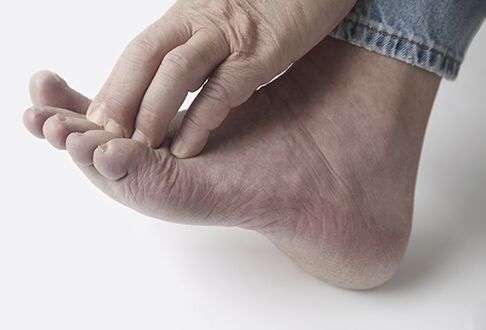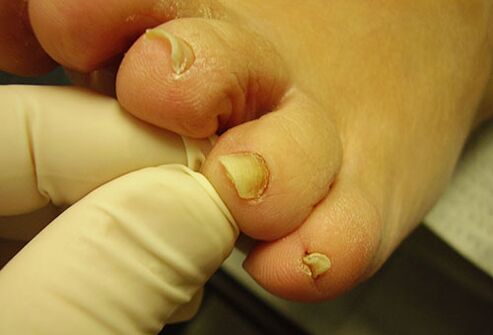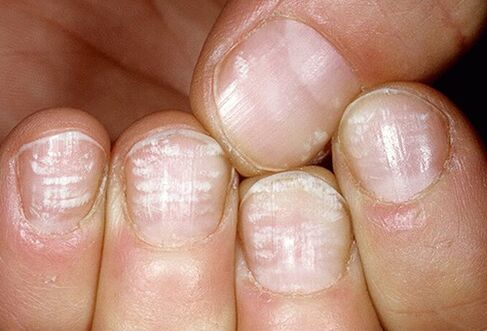Nail fungus is not to be confused with anything advanced, as it is nearly impossible to cure it. However, if you know the early symptoms of nail fungus, it's not too late to start fighting the infection and keep your nails from falling out. But fungi look different in different situations, so first you have to have some idea of the nature and course of the disease.

general signs of illness
These symptoms will remain the same regardless of the type, variety, course, or even stage of the fungus and definitely indicate that onychomycosis is developing or has occurred.
- Changes in the color of the nail plate are a key sign that the disease is starting to develop. Shades vary from white to black, but the most common color of fungal nails is tan.
- An unpleasant odor always accompanies onychomycosis, although it may not be very noticeable in the initial stages. Granted, you hardly ever smell your feet, and during the developmental stage of the disease, a certain odor becomes apparent.
- Delamination, chipping, and flaking of the nail plate doesn't start right away, but it's these signs of nail fungus that set off alarm bells for most people. If these symptoms are expressed in moderation and localized, there is still an opportunity to restore the nail to a healthy appearance.
- Pain sensations are rare in the initial and developing stages, but as the disease progresses, discomfort and pain are unavoidable: in any case, either due to deformation, destruction of the nail plate, or flare-ups of inflammation and pus.
- Burning and itching of the skin should also not be ignored. Also, in the initial stage, it is these symptoms that help to identify the disease, as in some cases it is passed from the skin on the lateral or posterior ridges or stratum corneum to the nail plate.
Incidentally
Onychomycosis is more common on toenails, while the fungus occurs much less frequently on hands, most commonly after contact with an affected toenail.

Symptoms of tinea pedis
It appears that you already know how to identify nail fungus, but this information is very general, although it can be helpful in accurately diagnosing onychomycosis. The truth is, there are more than 50 species of fungi that can cause it, with about 10 disease courses. It's best to know ahead of time what awaits you in every possible situation.
More than 90% of cases of onychomycosis of the legs are caused by skin fungi, just under 10% are caused by yeast-like fungi, and only a small percentage are caused by mold.
Different types of nail fungus provide different symptoms.
- With a nutritionally normal fungus, the nail plate itself is not deformed, and the most obvious manifestation of the disease is that the color of the plates on both sides changes to yellowish-brown. At the same time, its thickness does not change, it does not break, and its natural luster does not disappear. If the nutritious fungus is not treated, it will affect the area to increase and the board will start to peel and possibly fall off completely.
- The hypertrophic fungus can cause the nail plate to thicken, leading to the formation of growths that look like claws. In advanced stages, the fungus can cause discomfort and pain when walking, and of course, the nail damage is accompanied by a gray or yellow discoloration. Such nails lose their natural luster and begin to chip and fall off.
- If you are faced with atrophic fungus, the risk of losing your plate without proper treatment is very high. The fungus gradually destroys the nail plate, loosening and flaking it, causing it to shrink as a result. At the initial stage, it is difficult to distinguish the atrophy process, as it is only accompanied by tarnishing and a change in plate color to yellow, brown or gray.
Less typical is a distal lateral fungus with advanced blackening, pain, purulence, and atrophy of the nail plate; a proximal fungus with white spots in the growth area, causing damage to the nail plate laterally from the cuticle, and a whitish, pale fungusEpiphytes, which appear on the nails in the form of small white dots, gradually grow and occupy larger and larger areas.
Incidentally
The older you are, the more likely you are to get nail fungus. Furthermore, the occurrence of fungi may be influenced by climate, hygiene and gender.

Symptoms of fungus on hands
In the hands, the main 3 variants of the disease process were indistinguishable from those encountered in the legs, only the distribution of causes of occurrence was different: approximately 30% and 45% were due to dermatophytes and yeast-like fungi, respectively, slightly lessFifteen percent were mold, and a few infections were caused by other fungal organisms.
The main symptoms of plates on the arms and legs are also the same, and the affected areas look similar. The only difficulty may be the problem of identifying nail fungus in less common cases, such as erythromycosis or trichophyton infection, but this is more of a task for a qualified doctor.

Progress in fungi
If in the early stages the disease does not seem dire, with little thought for serious treatment, and is increasingly being replaced by folk methods, then in the later stages, no long-term medical treatment is possible. Even it doesn't guarantee that the nails will stay with you.
- Early initiation of treatment for the disease is ideal, but it is nearly impossible to determine outside the laboratory: all symptoms are barely noticeable. Although some signs can still be seen. If you notice problems with your skin, such as possible cracks, blisters, or burns, this is an obvious sign of onychomycosis on your nails. It's also a cause for concern if you see that the color of the nail plate has started to change along or from one edge.
- Usually, the fungus becomes apparent during the developmental stage, and in order to notice it as early as possible, you need to regularly perform at least a simple pedicure and monitor the condition of the nails and the skin of the feet. During this time, the nail plate looks unhealthy, loses its luster, and begins to change significantly in color, and near the late stage, the nail begins to deform, peel, and chip.
- At an advanced stage, the nail will definitely collapse actively: delaminate, break, loosen, until it completely destroys the nail plate and even the nail bed. In order for the disease to reach its advanced forms, it must be ignored for a considerable period of time, enduring the itching, discomfort, nauseating appearance and unpleasant odor that people still do not often. Therefore, this stage is typical of the rapid development of fungi in old age or in the presence of certain diseases.
It's important to remember that untreated nail fungus can turn into foot fungus, and the disease is more unpleasant and difficult to treat.
It is not difficult to determine if there is fungus on the nails, at least during the development stage, but it is best to entrust a qualified professional to determine the cause and type of course. Don't ignore your doctor's help and contact them when you first suspect an illness.
























